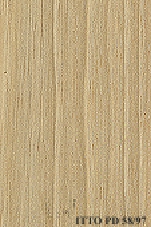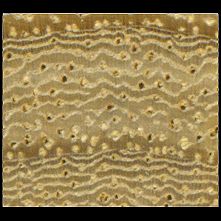
TERMINALIA (Terminalia calamansanai)
Trade Name
Terminalia
Scientific Name
Terminalia calamansanai (Blanco)
Family
COMBRETACEAE
Common Names
Tinnok (Thailand); Khimot (Thailand); Lein (Myanmar); Kalamansanai (Philippines); Malakalumpit (Philippines); Jelawai mentalun (Malaysia); Leni (Myanmar)
Scientific Name Synonyms
Terminalia latialata C.T. White.; Terminalia pyrifolia (Presl) Kurz; Terminalia blancoi Merr.
Description Of The Tree
Botanical Description
This species is described as a medium sized to fairly large tree up to 40 meters tall, with diameters which can reach up to 200 cm. It presents tall buttresses which can be up to 10 meters high.
Natural Habitat
Terminalia calamansanai is found in deciduous forests, on roadsides, also near the sea, at low and medium altitudes.
Plantations Available?
Plantations of this species are reported in the Solomon Islands.
Wood Identification
Anatomic Description Of Wood
Vessels per mm2 less than 6 (rare). Occasionally tyloses common. Tangential diameter of vessel lumina 200 micras or more (large). Vestured pits. Vessel-ray pits similar to intervessel pits in size and shape. Simple perforation plates. Intervessel pits medium, 7 Axial parenchyma in marginal or in seemingly marginal bands. Axial parenchyma bands more than 3 cells wide. Oil and/or mucilage cells in axial parenchyma (idioblasts). Ray height more than 1 mm. Rays more than 10 per mm (abundant). Rays 1 to 4 seriate. Septate fibers present. Fibers with simple to minutely bordered pits.
-
 Wood Macro Photo Radial Plane
Wood Macro Photo Radial Plane
-
 Wood Micro Photo Of Transversal Section
Wood Micro Photo Of Transversal Section
Availability
Cites Status
Unrestricted
General Wood Description
Color
The sapwood and heartwood are not clearly demarcated. The timber is yellowish brown.
COLOR INDEX (1=Black, 7=Light yellow,white)
5
Grain
The grain is straight or shallowly interlocked.
Texture
The texture is medium to coarse.
Luster
It is reported to be slightly lustrous.
Natural Durability
The wood is considered as non durable to moderately durable.
Natural durability index (1= Very high durability, 7=Vey low durability)
6
Internal Growth Stresses
Tension wood is frequently observed in this species.
Resistance To Impregnation
The heartwood is moderately resistant to preservative treatment, but the sapwood can be readily treated.
Wood Physical Properties
Basic Density or Specific Gravity (O.D. weight/vol. green) (g/cm³)
0.65
Air-dry Density (Weight and volume at 12%MC) (g/cm³)
0.73
Total shrinkage Tangential (Saturated to 0%MC) (%)
8.4
Total shrinkage Radial (Saturated to 0%MC) (%)
5.2
Recommended Dry Kiln Schedule
JP-12
Dimensional stability ratio (Total Tangential Shrinkage %/Total Radial Shrinkage %)
1.6
Wood Chemical Properties
Wood Mechanical Properties
Bending Strength (MOR),12%MC (kgf/cm²)
941
Stiffness (MOE) 12%MC (kgf/cm²)
94000
Compression parallel to fiber 12%MC (kgf/cm²)
464
Workability
Sawing
It saws fairly well, occasionally woolly surfaces are reported.
Rotary Veneer Cutting
This species is reported to have good characteristics for lamination.
Sliced Veneer
This species is reported to have good characteristics for lamination.
Machining
Machining of this species is easy to fair.
Nailing
Pre-boring is often necessary.
Gluing
It is reported to be easy to glue.
Finishing
It finishes satisfactorily.
REFERENCED USES
End Uses Summary
HOUSING GENERAL, FURNITURE AND CABINETS, PLYWOOD AND VENEER, TOOLS, tool handles
General Housing
- 10 - Silica in Timbers
Furniture Cabinets
- 21 - Tropical timbers of the world. Part III-Southeast Asian and Oceanian Species.
Panels, Veneers
- 25 - Directory of Timber Trade Malaysia
Tools
- 42 - Utilización Industrial de Nuevas Especies Forestales en el Perú.
Tool Handles
- 43 - Maderas de Bolivia (Características y Usos de 55 Maderas Tropicales)
Please Provide Information To View Producer Information